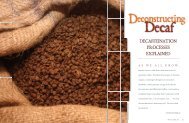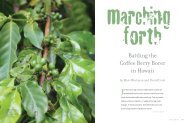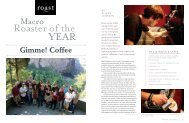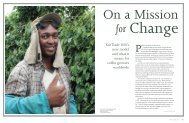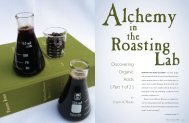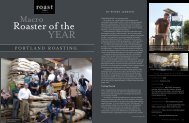a guide to the coffee taster's flavor wheel - Equal Exchange
a guide to the coffee taster's flavor wheel - Equal Exchange
a guide to the coffee taster's flavor wheel - Equal Exchange
You also want an ePaper? Increase the reach of your titles
YUMPU automatically turns print PDFs into web optimized ePapers that Google loves.
A Well-Rounded Palate | A Guide <strong>to</strong> <strong>the</strong> Coffee Taster’s Flavor Wheel (continued)<br />
found in <strong>the</strong> <strong>coffee</strong>, while a term like “maple syrup” in <strong>the</strong> sugar<br />
browning category indicates <strong>the</strong> development of sugars. And, finally,<br />
terms like “clove” from <strong>the</strong> dry distillation directly reflect bean fiber.<br />
Ano<strong>the</strong>r <strong>to</strong>ol that <strong>coffee</strong> professionals have is <strong>the</strong> set of aroma<br />
vials that were developed by Jean Lenoir, <strong>the</strong> famous crea<strong>to</strong>r of wine,<br />
champagne and cigar aroma kits. For <strong>coffee</strong>, Lenoir had specific ideas<br />
about <strong>the</strong> aromatics found in <strong>coffee</strong>, as did Lingle. Upon meeting in<br />
Paris <strong>to</strong> begin working on <strong>the</strong> aroma vial kit, <strong>the</strong>y found that <strong>the</strong>ir<br />
ideas were in alignment. Amazingly enough, with all of <strong>the</strong> possible<br />
aromas you could find in <strong>coffee</strong>, <strong>the</strong>se two professionals were able<br />
<strong>to</strong> settle on a list of 36 terms. Through <strong>the</strong>ir process of exchanging<br />
information, <strong>the</strong>y had <strong>to</strong> change only four terms <strong>to</strong> come <strong>to</strong> an<br />
agreement. Considering <strong>the</strong> wide variety of terms that many cuppers<br />
find outside of <strong>the</strong> aroma section of <strong>the</strong> <strong>flavor</strong> <strong>wheel</strong>, this is very<br />
interesting.<br />
“dearth” of words available in <strong>the</strong> English language <strong>to</strong> describe <strong>flavor</strong>.<br />
In <strong>the</strong> taste category, you don’t find <strong>the</strong> wide-reaching descriptions<br />
that one associates with actual <strong>flavor</strong>s. What was interesting <strong>to</strong> me<br />
was <strong>the</strong> idea that aroma captures many of <strong>the</strong> sentiments we have as<br />
cuppers, but <strong>the</strong> actual <strong>flavor</strong> terms of sweet, sour, salt and bitter seem<br />
<strong>to</strong> be a limiting group.<br />
Imagine a scenario where you identify a <strong>coffee</strong> as being sweet; <strong>the</strong><br />
<strong>flavor</strong> <strong>wheel</strong> provides you with more taste options within <strong>the</strong> sweet<br />
category, and you decide <strong>the</strong> <strong>coffee</strong> <strong>flavor</strong> “mellow” does <strong>the</strong> best job of<br />
capturing your sentiments (see page 38 for a cross-section of this part of<br />
<strong>the</strong> <strong>wheel</strong>). You now have <strong>the</strong> option <strong>to</strong> take “mellow” a step fur<strong>the</strong>r;<br />
you are left with two more options: “mild” and “delicate.” Both tasting<br />
terms are familiar; <strong>the</strong>y seem similar in concept and are widely used.<br />
How are <strong>the</strong>y different? It seems like tasters could proceed at this point<br />
with a judgment call and interpret <strong>the</strong> words in whatever way <strong>the</strong>y<br />
want <strong>to</strong>. But that is not <strong>the</strong> intended use for <strong>the</strong> taste side of <strong>the</strong> <strong>flavor</strong><br />
<strong>wheel</strong>. The vocabulary used refers <strong>to</strong> specific measurements with<br />
adjacent <strong>flavor</strong>s on <strong>the</strong> <strong>wheel</strong> contributing <strong>to</strong> <strong>the</strong> intensity of a specific<br />
<strong>flavor</strong>. Use <strong>the</strong> flow chart breakdown for descriptions, which will help<br />
cuppers justify why one term is better than ano<strong>the</strong>r.<br />
The <strong>flavor</strong>s you experience on <strong>the</strong> cupping table or enjoy in your<br />
brew encompass <strong>the</strong> basic four <strong>flavor</strong>s of sweet, sour, salt and bitter.<br />
Though <strong>the</strong> basic four don’t sound like <strong>the</strong> sexy terms we like <strong>to</strong> use<br />
<strong>to</strong> describe <strong>the</strong> fine attributes in <strong>coffee</strong>, terms like “apricot” or “maple<br />
syrup” are actually aromatics that are described as <strong>flavor</strong>s due <strong>to</strong> <strong>the</strong><br />
open passage between <strong>the</strong> palate and <strong>the</strong> nasal passage that allows us<br />
<strong>to</strong> experience <strong>the</strong>se characteristics retro-nasally; thus, <strong>the</strong>y become<br />
part of our <strong>flavor</strong> description.<br />
The Tastes<br />
You may have learned about four basic tastes through an SCAA class,<br />
<strong>the</strong> Q-grader course or your own background and curiosity about<br />
fundamental <strong>flavor</strong>.<br />
At <strong>the</strong> center-left side of <strong>the</strong> right <strong>flavor</strong> <strong>wheel</strong> you will see <strong>the</strong><br />
term “tastes.” Skirting this word are <strong>the</strong> four basic tastes believed <strong>to</strong><br />
be in <strong>coffee</strong>: sour, sweet, salt and bitter. Lingle pointed out that not<br />
only are <strong>the</strong>re fewer terms on this side of <strong>the</strong> <strong>wheel</strong>, but that <strong>the</strong>re is a<br />
What About Umami?<br />
After attending <strong>the</strong> Applied Sensory and Consumer Science Certificate<br />
Program at <strong>the</strong> University of California, Davis, I was certain that <strong>the</strong><br />
basics of <strong>flavor</strong>s were not fairly represented on <strong>the</strong> <strong>flavor</strong> <strong>wheel</strong>. For<br />
one, an important discovery made about <strong>the</strong> way food products can<br />
taste, dubbed “umami,” was not being represented. I wondered if<br />
<strong>the</strong>re were plans <strong>to</strong> include this fifth taste in a future version of <strong>the</strong><br />
<strong>flavor</strong> <strong>wheel</strong>. However, Lingle has an opposing opinion about umami.<br />
He asserts that <strong>the</strong> <strong>flavor</strong> of umami is a modulated version of salt<br />
introducing fat—basically a merger of salt with water-soluble oil,<br />
much like <strong>the</strong> <strong>flavor</strong> of seaweed and widely known as monosodium<br />
glutamate (MSG). Therefore, he says, it is a subset of salt on <strong>the</strong> Coffee<br />
Taster’s Flavor Wheel.<br />
The Limits<br />
Let’s assume that <strong>the</strong> <strong>flavor</strong> <strong>wheel</strong> is open <strong>to</strong> interpretation and that<br />
it can be used in many different ways. What happens when <strong>the</strong>re is a<br />
descrip<strong>to</strong>r that is not listed on <strong>the</strong> <strong>flavor</strong> <strong>wheel</strong>? (I am certain that ume<br />
pho<strong>to</strong> courtesy of <strong>Equal</strong> <strong>Exchange</strong><br />
plums are not on it.) The <strong>flavor</strong> <strong>wheel</strong> has always provided my mind<br />
with freedom and creative license, but upon reading The Coffee Cupper’s<br />
Handbook, I began <strong>to</strong> look at <strong>the</strong> <strong>wheel</strong> through a more restrictive and<br />
less creative lens.<br />
I had never thought of <strong>the</strong> <strong>flavor</strong> <strong>wheel</strong> as a limiting <strong>to</strong>ol, but<br />
ra<strong>the</strong>r a way <strong>to</strong> encourage tasters <strong>to</strong> dig in<strong>to</strong> <strong>the</strong>ir aroma and <strong>flavor</strong><br />
memories and pull out a term that would be interpreted through <strong>the</strong><br />
<strong>coffee</strong> <strong>the</strong>y are tasting. What I learned is that <strong>the</strong> right-hand <strong>wheel</strong>,<br />
<strong>the</strong> one containing tastes and aromas, is believed <strong>to</strong> represent <strong>the</strong><br />
limits in <strong>coffee</strong>. Knowing that green <strong>coffee</strong> contains more than 200<br />
chemical compounds before it is roasted and hundreds more after<br />
roasting, shouldn’t <strong>the</strong>re be more than 36 aromas and four basic tastes?<br />
It makes sense that cuppers would venture outside <strong>the</strong> lines of <strong>the</strong><br />
<strong>flavor</strong> <strong>wheel</strong> when encountering a particular aroma memory, which is<br />
based on experience and access <strong>to</strong> <strong>the</strong> vocabulary presented. However,<br />
<strong>the</strong> <strong>flavor</strong> <strong>wheel</strong> is meant <strong>to</strong> create a common vocabulary. I believe it<br />
continued on page 46<br />
44 roast May | June 2012 45





